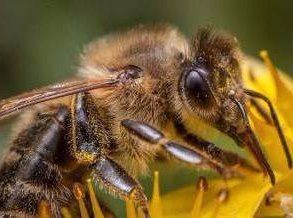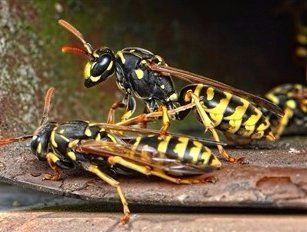Chihuahua Stung by Bee, Wasp, Hornet, Yellow Jacket, Fire Ants
Overview
When you have a very small breed like the Chihuahua, there may seem to be danger lurking around every corner. And when the weather is warm, with bees and other stinging venomous insects abound, this is truer than ever.
If a Chihuahua puppy, adult or senior is stung by a bee or other insect, not only can this cause pain but it can also lead to either an allergic reaction or, if there are multiple stings, an overdose of toxic venom.
As an owner, you will want to be prepared, a puppy or dog does not need to disturb a nest to get stung; it can happen simply by walking outside. It can happen in your own yard, while being taken around the neighborhood or at the dog park. Some dogs have even been attacked by bees while in the car.
To be help you be ready should this ever happen, this section will discuss:
- What you need to know regarding the danger of bees, hornets, yellow jackets, wasps and red ants
- How to react to a sting(s)
- At home treatment
- Allergic reactions and red flags of a bee sting medical emergency
- Prevention
Possible Dangerous Allergic Reactions
Dogs, just like humans, can be allergic to bee stings. They can also be allergic to other venom including wasps, hornets, yellow jackets and even red ants.
One tricky aspect of this is that it happens on a case by case basis; a dog can suffer an allergic reaction to a bee sting even if he was okay in the past.
In addition, a puppy or dog may react differently depending on which sort of insect stings him; a wasp may be tolerated but a sting from a hornet could cause a life-threatening reaction. Ahead we will discuss signs and treatment of this, as it is considered a medical emergency.
Aside from that a huge concern with tiny toy breeds like the Chihuahua is the concern of a buildup of toxins, which is a separate problem from
allergic reactions. For dogs, 10 stings per 2.2 pounds of body weight can be fatal and 5 stings per 2.2 pounds of body weight can cause a dog’s system to be overwhelmed, causing acute illness. And for young puppies, it may be even fewer than this. These are numbers easy to reach should a swarm of bees attack your Chihuahua.
For example, with a 5 pound Chihuahua, 25 stings can cause the body to be overloaded with venom and 50 stings could be deadly.
Please note that with multiple stings of bee or wasps, serious issues can occur days after a bee attack. Proteins in the venom break down and can damage cells in the body. The kidneys can then become clogged, causing kidney failure.
Stinging Insects and the Dangers to your Chihuahua
Vulnerability – Though you may notice bees most often when they are buzzing around the air, many stinging insects live at ground level or under the ground (exiting at ground level), which puts the Chihuahua at risk when he walks over grass or sniffs around outside.
And while the fur of a Chihuahua will protect him to some degree, it is not thick or abundant enough to thwart a bee attack. This said, the face, belly and paws are often stung more often than other parts of the body.
Bees
– There are 20,000 different types of bees and the majority of them are a danger to dogs. In fact, a huge myth is that the fat, round bumblebee does not have a stinger; the truth is that worker bumblebees can indeed sting.
Also, ONLY the honeybee dies after stinging one time; all other types of bees can sting multiple times.
Honeybees have barbed stingers that rip out their abdomen when pierced into flesh, causing the insect to die; however, all others have smooth stingers, allowing attacks to continue until there is intervention or the bees tire out.
Carpenter bees, mining bees and sweat bees (these have green on them) are very common in most of the U.S.
70% of bees make their home at or under ground level, which means that they can be disturbed and attack a Chihuahua simply by the puppy or dog sniffing near the nest or walking over it.
One of the most shocking cases of bees attacking dogs happened in Scottsdale, in which a woman, her 3 dogs were swarmed by an estimated 65,000 bees that suddenly flew out of an enormous nest that was built into an apartment complex wall.
While she tried to hide in her bathroom with the dogs, all 3 dogs died; two of them from the sheer number of bee stings and the other needed to be euthanized.
But it can also happen just about anywhere; in Peoria, Arizona a woman was driving with her dog when bees entered the car
through an open window; the dog did not survive the attack.
Yellow jackets, hornets and wasps - Under the classification of vespid wasps are paper wasps, yellow jackets and hornets.
While all can potentially sting a Chihuahua, the yellow jacket that builds its home at ground level, making him the one of the biggest threats. In addition, yellow jackets can both sting and bite.
Though many wasps build nests in high, protected areas that will be out of reach of a Chihuahua, the ground digger wasp lives under the ground, often building a large network of tunnels under lawns and gardens.
And wasp bites to a dog can be severe as the venom contains a special element that slows down blood flow and therefore delays any dilution of the toxin.
Hornets are especially territorial and
aggressive; a dog innocently walking by can be enough to trigger hornets to sting.
These stings are often more painful than bee stings due to a larger amount of acetylcholine which stimulates pain receptors.
It should be noted that if a Chihuahua has had an allergic reaction to a hornet, there is a high chance of being allergic to wasps and vice versa.
Fire ants
– Also called red ants (though some varieties are brown), these are a danger to dogs simply because their ant hills are where dogs may sit or lie down when outside. They like to live in moist areas, so they may be present along rivers and ponds and even in well-watered lawns and parks.
They both bite and sting, injecting a venom that is very painful (hence the name). Hundreds will crawl on an animal at one time and since these are so little, they can quickly make their way onto sensitive areas of a Chihuahua, including genitals and armpits, biting
and stinging along the way.
Cali, at 14 weeks old
Photo courtesy of Reonna
What to Do if Your Chihuahua is Stung by a Bee or Other Insect
How you react if your Chihuahua puppy or dog is swarmed or attacked by bees or other insects will play a huge role in how many times he is stung. And the steps you take immediately afterward will cut down on his discomfort and can even save his life.
Know the warning signs:
While a Chihuahua may get stung on a paw when stepping on a bee and a very disturbed nest can suddenly swarm, in many cases a bee will buzz around one’s head as a warning. If you see bees or other insects buzzing around you or your Chihuahua, it is time to leave the area (more ahead). Also, if your Chihuahua is stung once by a honeybee and the insect dies, do not assume it is over; that sting let out a pheromone that tells other bees to attack the “invader”, so more may be on their way.
What not to do:
Do not swat at the insects: While this may be your first reaction, this typically angers them more.
What to do:
While it may seem simple, the best answer is to run, but you will want to do so in a particular way:
1. Pick up your Chihuahua,
holding him close to your body. If you can, tuck him under your shirt; stingers will
puncture through clothing, but it does help a bit. Also if possible, pull up the top of your shirt to shield your face without blocking your line of sight.
2.
Leave non-essential items behind.
If bees are actively stinging your Chihuahua, getting your puppy or dog to safety should be your top priority.
3. Your goal is to run to shelter.
This can be your car, your house or other building. Some bees may follow you, however most will be stopped by the door. In a dwelling, run to a center, darkened room; bees, hornets and others are often confused by window light and may fly to the glass.
4. Speed and distance.
It is not possible to run faster than a bee can fly; they can top 12 mph. However, if you have several options, run into the wind. Also, run in a straight line. And most importantly, if you cannot seek shelter, your goal will be to run with your Chihuahua at least 50 yards (about 75 steps); this is the point that most bees will give up. Do keep in mind that very aggressive bees can give chase for 100 yards and Africanized bees have been known to chase victims for up to a mile (in the United States, these are most commonly found in, Arizona, Florida, Nevada, New Mexico, southern California and Texas).
5. Immobilize the bees.
If any bees or other venomous insects are still on your Chihuahua, bring him to a sink or tub to douse him with water and lots of shampoo; the soap film will immobilize the insects. You can then rinse them off your dog.
Fire ants- If your Chihuahua has fire ants crawling on him, the water and soap method will work as well. You will want to use a nozzle if possible so that the stream of water is strong. Lift fur
and rinse all areas of your Chihuahua’s body until all of the ants are removed.
Home Care and Remedies if a Chihuahua is Stung
Many owners want to know if they need to bring their Chihuahua to the veterinarian if the puppy or dog is stung by bees, wasps or other.
And the answer will depend on how many times your dog was stung and if he is showing any signs of a reaction. If you estimate a total of 15 to 20 stings, it is best to call the vet and ahead we will discuss symptoms of an allergic reaction, which can occur with just 1 sting.
1. Remove stingers.
With honeybees, the barbs on the stingers will cause them to embedded in the skin. Do not use your fingers or tweezers to remove these, as doing so can cause more venom to be released into your Chihuahua’s system. You will want to use a credit card to scrape them out. Be sure to check all areas: under the tail, in between paw pads, etc.
2. Bathe your Chihuahua.
Giving your dog a quick shampoo can help remove natural body oils that would otherwise get in the way of topical solutions that are part of treatment.
3. Benadryl.
With your vet’s approval, giving Benadryl
can help decrease swelling and treat minor cases of itching and allergic reaction. Typical dosing for canines is 1 mg (NOT ml) per pound of body weight, given every 8 hours.
4. Apply a topical.
The goal is to use a paste to neutralize the acidic venom. For a Chihuahua with bee stings, yellow jacket stings or fire ant bites, a mix of baking soda and water works best. Once you mix this into a thick paste, apply it to any marks for 15 minutes. You may need to rinse that off and repeat a second time. For wasp and hornet stings, cotton balls soaked in vinegar often works best to neutralize that particular venom, though baking soda will work to some degree if you do not have any vinegar.
Do not use both vinegar and baking soda at the same time, as they will render themselves inactive.
5. Apply ice.
In cases of minor swelling (moderate to severe swelling is a red flag), gently pressing an ice pack on those areas can help decrease the inflammation.
6. Monitor your Chihuahua. Perhaps the most important element of all, is to closely monitor your Chihuahua to see how his body is reacting. Remember that it can happen to a dog even if he did not previously have one. And a tolerance for one insect does not apply in regard to others.
There are 2 dangers:
allergic reaction causing anaphylaxis and accumulation of venom may induce a toxic reaction.
This can occur up to 45 minutes afterward AND in cases of multiple stings that result in kidney failure, it can be days afterward.
Signs of a Bee Sting Allergic Reaction
Dogs, like humans, can have a severe, life-threatening allergic reaction, known as anaphylactic shock. Signs include:
Abnormal swelling
– This may be most apparent on the face; eyes and lips will become swollen. It may also present as traveling inflammation originating from the body part that was stung, for example a sting on the paw that causes the entire legs to swell.
Breathing problems – This includes any wheezing, coughing
or raspy-sounding breaths.
Other less common, but still possible signs, include:
cold limbs, odd behavior, drooling, loss of bladder and/or bowels, rash and/or vomiting.
Hermes, at 1 year old
Photo courtesy of Elisa Testa
Signs of Toxic Reaction to Multiple Stings
This refers to an overload of toxins that a Chihuahua’s little body cannot handle and is a concern that is independent of any allergic reaction. This is a risk if a dog is stung multiple times (often 20 or more). And remember that during a bee attack, panic and reaction may prevent you from knowing the count.
Symptoms include: diarrhea, dizziness, fainting, fever, vomiting, lethargy and/or convulsions.
Emergency Treatment
In the case of a bad reaction, time is of the essence and you will want to get your Chihuahua to the vet as soon as possible. Epinephrine and corticosteroids are often given. In severe cases, an emergency airway may need to be established. Additionally, IV intervention may be given to help with shock and dehydration.
Most dogs suffering from anaphylaxis or toxic buildup need to remain in the clinic for 2 to 3 days.
If your Chihuahua is found to be allergic to bees or other types of venom, your vet should prescribe an EpiPen for you to keep with you whenever you take your Chihuahua outside.
Helping to Prevent a Chihuahua from Getting Stung
It is important to note that owners should not refrain from taking their Chihuahua outside for his daily exercise or cut down on time spent outside.
Exercise and outdoor playtime is crucial for both physical health and emotional well-being.
But there are things that you can do to help prevent your Chihuahua from getting attacked by bees and other stinging insects.
1. Supervise your Chihuahua.
There is a host of reasons why a Chihuahua should never be let outside alone, and this is just one of them.
Enclosed yards or being leashed outside may stop a dog from running away, but these things can be a deadly trap if bees attack.
Cosimo, at 4 months old
Photo courtesy of Maria Sciandra
2. Control sniffing.
Dogs often get stung on their noses due to sniffing under bushes or in other areas where a nest may sit. If you have your Chihuahua on a harness, you can safely pull him back should he try to stick his nose in a danger spot.
3. Check the area.
Routinely check all areas of your yard for signs of ground dwelling insects and your house, any sheds and trees close by for nests. If you do spot a colony of bees, we recommend having a professional exterminator take care of the problem. When you bring your Chihuahua out for a walk or to the park, report any large hives to your town; many towns will have hives removed if they are in public places where people, especially children, congregate.
4. Avoid ‘hot spots’.
Trash cans, flower beds, the area around fruit trees and any rotting wood are potential areas for bee, wasp and hornet activity.
5. During and after yard work - Such things as weed trimming, lawn mowing and pruning can disturb nearby bees and other stinging insects. And after a lawn is cut, the smell of freshly mowed grass can attract (and aggravate) bees. To play it safe, think about keeping your Chihuahua inside when these tasks are being performed and for about 2 hours after the lawn is mowed.
6. Play it safe.
Don’t be concerned about appearing overly protective if you wish to pick up your Chihuahua and move him from an area where there is a bee buzzing around. It’s always better to be safe than sorry.
A Final Word
Warm weather brings lots of great things: barbecues, picnics, swimming, family gatherings outdoors and more time spent in the sun. Bees are just a small part of the equation. With steps to prevent bee stings from occurring and the knowledge of how to react, have fun with your Chihuahua… in many parts of the country,
winter will come around far too soon so enjoy spring and
summer while you can.
Did you find this article helpful?
If so, you'll love The GIANT Book of Chihuahua Care!
Things you may wish to do now:
Become a free PetChiDog Member
- You will be able to receive friendly reminders when we add new pages to the site. You will also be able to suggest a topic for us to write about. * If you are already a Member, just reply to any newsletter with your idea.









